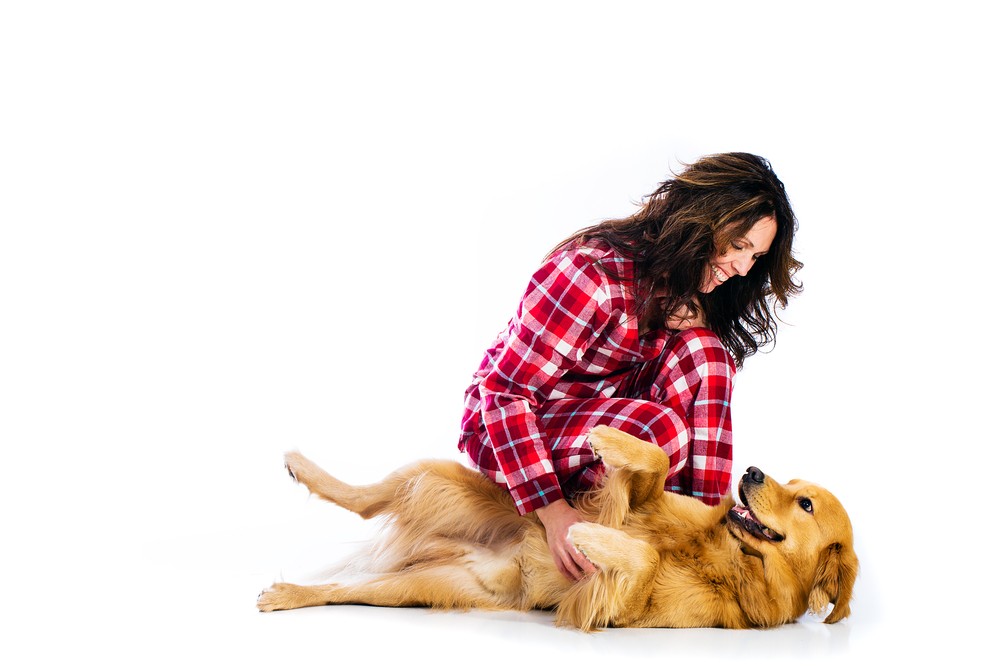Have you ever been petting your dog, enjoying a bonding moment filled with belly rubs, when suddenly their back leg starts moving uncontrollably? It’s a common sight for dog owners: you find that “sweet spot” while scratching their belly, and their leg goes into overdrive, kicking as if they’re running in their sleep. This funny and somewhat puzzling behavior leaves many wondering – Why Do Dogs Kick When You Scratch Them? Are they ticklish? Is it a sign they like it, or is something else entirely going on?
 Dog enjoying a belly rub and exhibiting the scratch reflex by kicking its leg. A woman's hand is scratching the dog's belly.
Dog enjoying a belly rub and exhibiting the scratch reflex by kicking its leg. A woman's hand is scratching the dog's belly.
Let’s delve into the science behind this quirky dog behavior and uncover the mystery of the kicking leg during a belly scratch.
The Curious Case of the Kicking Leg: It’s the Scratch Reflex
Most dog owners can attest to the joy their canine companions seem to derive from a good belly rub. From the smallest Chihuahua to the largest Great Dane, many dogs adore having their bellies scratched. And it’s often during these belly scratching sessions that the leg-kicking phenomenon occurs. These kicks can look quite pronounced, resembling a running or even swimming motion performed on their side. It can seem strange and elicit a chuckle, but it’s actually a perfectly normal physiological response known as the scratch reflex.
Unpacking the Scratch Reflex: An Involuntary Response
The kicking you observe isn’t a sign of your dog being ticklish in the human sense, nor is it necessarily a conscious expression of extreme pleasure – though they might still be enjoying the attention! Instead, it’s an involuntary reflex, much like the knee-jerk reflex that doctors test by tapping your knee. This type of reflex is designed to protect the body from irritants.
How the Reflex Works: A Speedy Nerve Pathway
Beneath your dog’s skin are nerves that are connected to the spinal cord. When you scratch that “sweet spot,” you are actually stimulating these nerves. This stimulation triggers a message that is rapidly sent to the spinal cord. The spinal cord, in turn, sends a signal directly back to the leg muscles, instructing them to contract and cause the kicking motion. Importantly, this entire process happens without the signal needing to travel all the way to the brain for processing. This quick, direct pathway is what makes it a reflex – an automatic, involuntary response.
Not Ticklish, But Startled: A Survival Mechanism
While we might find the kicking funny, it’s likely not a source of amusement for your dog in the same way. In fact, this reflex is believed to be a survival mechanism designed to help dogs (and other animals) get rid of irritants like fleas or ticks. Imagine an insect landing on your dog’s side; the scratch reflex would be activated to quickly dislodge it. The sensation of scratching, even when pleasurable from your petting, can trigger the same neural pathway. This is why your dog might seem a little surprised or puzzled by their own leg movements – it’s a reflexive reaction, not a consciously initiated action. You might observe a similar reflex in cats when you scratch the base of their tail, often resulting in them raising their rear end.
Veterinary Significance: Checking Neurological Health
Interestingly, this seemingly simple reflex can be a valuable tool for veterinarians. By testing the scratch reflex, vets can assess the health of your dog’s nervous system. A lack of response or an abnormal response could indicate potential nerve damage or neurological issues in specific areas of the body.
Common Involuntary Reflexes: We Have Them Too!
Involuntary reflexes are not unique to dogs; humans experience them as well. Think about blinking when something suddenly comes close to your eye, or quickly pulling your hand away from a hot stove. These are all examples of involuntary reflexes designed to protect us from harm, and the scratch reflex in dogs serves a similar protective function.
Putting It All Together: Keep Those Belly Rubs Coming!
So, does your dog kick when you scratch their belly? Now you know why! And should you stop giving them belly rubs? Absolutely not, unless your dog shows signs of discomfort or actively tries to stop you. If your dog enjoys belly scratches, continue to shower them with this affection. The leg-kicking is a normal, involuntary response and doesn’t diminish their enjoyment of your attention. Continue to cherish those bonding moments and enjoy the funny quirks of our canine companions!

